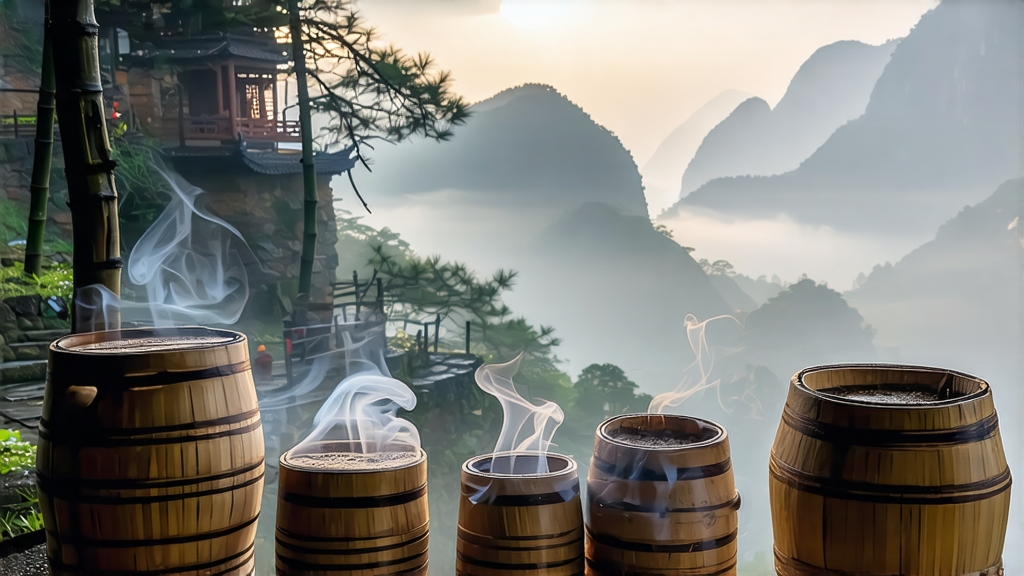
When European tea drinkers first encountered the bold, smoky aroma of Lapsang Souchong in the early seventeenth century, they were tasting the very beginning of black tea itself. Today the name is often reduced to “smoked tea” on supermarket shelves, yet the original Zheng Shan Xiao Zhong grown inside Wuyi’s protected core zone is a delicate, complex leaf that perfumed the courts of Charles II and catalyzed the global thirst for bohea. To understand Chinese red (hong) tea, one must begin with the cultivar that taught the world what fully oxidized leaves can do.
History: From Mountain Hermit to Global Celebrity
Legend places the birth of Lapsang Souchong in 1568 at the Tongmu Guan pass, where fleeing soldiers forced local farmers to dry their green tea leaves overnight over fresh pine fires. The accidental smoke infusion delighted the Dutch traders who carried it to Batavia and then to London, where it sold for ten times the price of green tea. By 1662, when Catherine of Braganza served it at her wedding to Charles II, “souchong” had become shorthand for luxury. The East India Company’s subsequent attempt to replicate the tea in Assam and Ceylon marks the start of black tea industries across Asia, making Lapsang Souchong the genetic and cultural ancestor of every breakfast tea now poured from Dublin to Delhi.
Terroir: The Min River Gorge Microclimate
Authentic Zheng Shan Xiao Zhong can only be produced inside a 600-square-kilometer national reserve at 27° north latitude, where the Wuyi massif traps humid monsoon clouds against cliffs of volcanic tuff. Daytime temperatures hover around 18 °C; at night they drop to 12 °C, encouraging slow amino-acid accumulation in the buds. The forest canopy filters light to a soft, shifting dapple, while mineral springs percolate through weathered granite, delivering potassium and magnesium to the shallow roots of the xiao ye zhong (small-leaf) tea bushes. These bushes, many of them seed-propagated rather than cloned, have adapted over centuries to the terroir, developing a unique benzaldehyde precursor that translates into the tea’s signature longan-sweet finish.
Cultivars and Harvest Calendar
Within Tongmu, two closely related landraces dominate: Cai Cha, prized for its floral top notes, and Ye Cha, whose thicker cuticle withstands the smoking process. Plucking begins on Qingming festival when the standard is one bud plus two leaves, about 3.5 cm in length. A second, rarer picking called mi jian (honey tip) is taken two weeks later, consisting only of unopened buds coated in pale down; this becomes the prized Wu Yuan Xian Zong, a smoke-free, malt-sweet variant reserved for the domestic market. Leaves destined for traditional pine smoking are harvested slightly later, when the sclerenchymatous cells have thickened enough to absorb and later release resinous aromatics without collapsing.
Craft: The Eight-Step Pine-Smoke Choreography
Withering starts on bamboo racks suspended over dying embers of Masson pine. The fire is never allowed to flame; instead, smoldering slabs rich in resin generate a cool, fragrant smoke that drifts upward for six to eight hours while artisans turn the leaves every twenty minutes. Once the leaf is supple enough to twist without tearing, it is rolled in narrow bamboo baskets, a gentler action than the mechanized maceration used in CTC teas. Oxidation proceeds in cedar-lined trays kept at 24 °C and 85 % humidity; here the leaf reddens from edge to stem in exactly 110 minutes, timed by intuition and the scent of over-ripe apples. The crucial smoking phase follows: the semi-dried leaves are spread on sieves stacked inside a qing lou—a three-story wooden structure whose lowest level holds a pine-log furnace. Fresh resinous wood is added every forty minutes, and the tea absorbs volatiles such as α-pinene, longifolene, and guaiacol, compounds later shown to possess antioxidant and antimicrobial properties. After three cycles the moisture is reduced to 7 %, and the finished tea rests in unglazed clay jars for at least thirty days so that smoke and leaf volatiles marry into a seamless bouquet.
Grades and Sensory Lexicon
European brokers once classified Lapsang into four grades—P, S, PS